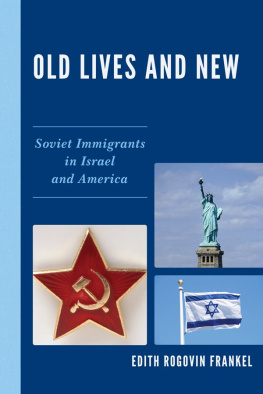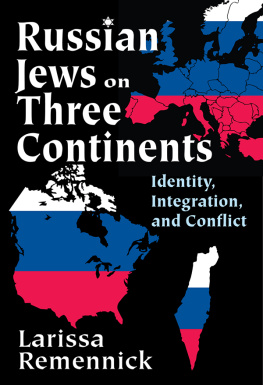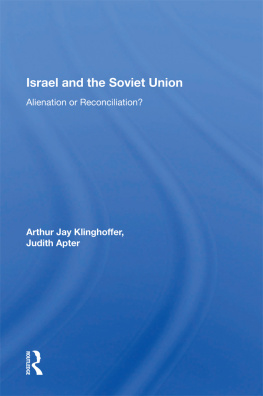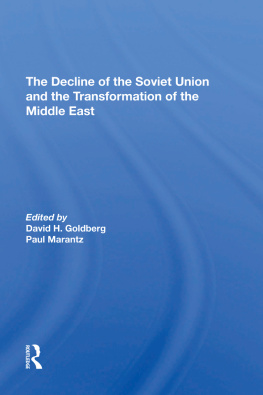The stories that she has collected with such diligence, and presents here with such clarity and skill, begin in the Soviet Union and end in Israel and the United States, the two main destinations of those who left Communism. The motives of those about whom she writes are set out clearly, as are their experiences. One of the strengths of this book is its portrayal of individuals: their personal stories, struggles, dilemmas and achievements. Each story is different, and each has lessons in it to illuminate and to inspire.
Sir Martin Gilbert , historian
By tracing the lives of several families and individuals over some two decades, Edith Rogovin Frankel illustrates the complexities of immigration generally and skillfully explores several dimensions of the experiences of Soviet Jewish immigrants in Israel and the United States. The twists and turns of Soviet Jewish lives are portrayed well by someone who has a deep understanding of their cultures, old and new.
Zvi Gitelman , professor of political science and Tisch Professor of Judaic Studies at the University of Michigan
Old Lives and New: Soviet Immigrants in Israel and America paints an incredibly sweeping and human portrait of Soviet Jewry over the past century. This immigrant group, which emerged out of the ruins of Communism, is captured through a series of individuals who tell the story from World War II and up through the trials and tribulations of immigrating and settling outside the Soviet Union at the end of the 20 th century. The best history does more than give us facts and figures; it tells us how people lived. Edith Rogovin Frankels work does that and more, interweaving the stories of a number of Soviet Jewish families in a way that makes a whole community come to life.
Gal Beckerman , author of When They Come for Us Well be Gone: The Epic Struggle to Save Soviet Jewry
Dr. Edith Rogovin Frankel has written a highly original and absorbing account of numerous interviews she conducted with emigrants (mainly Jews) from the Soviet Union. She spoke to them the first time shortly after they arrived in Israel and the United States in the late 1970s... and a second time twenty-five years later. There are poignant descriptions of the difficult lives of Jews in the Soviet Union who sought to observe the religious traditions of Judaism, and then there are moving descriptions of the difficulties in adjusting to conditions in new cultures, and of the joys of those migrsa high percentagewho succeeded, both professionally and socially.... The book tells an inspiring story that deserves a wide readership.
Abraham Ascher , Distinguished Professor Emeritus, Graduate Center, City University of New York
Old Lives and New
Soviet Immigrants in Israel and America
Edith Rogovin Frankel
Hamilton Books
A member of
The Rowman & Littlefield Publishing Group
Lanham Boulder New York Toronto Plymouth, UK
For my daughters Leora and Rachel, their husbands, Ilan and Jonathan, and my grandchildren:
Ariel, Eviatar, Dora, Daniel, Jordan, Keren, and Amitai Jonathan
with great love
And to the memory of my grandparents, the first modern-day immigrants in my family, who made their way from the Russian Empire to the American shores over a hundred years ago:
Molly and Abraham Sider
Dora and Jacob Rogovin
Copyright 2012 by
Edith Rogovin Frankel
Hamilton Books
4501 Forbes Boulevard
Suite 200
Lanham, Maryland 20706
Hamilton Books Acquisitions Department (301) 459-3366
10 Thornbury Road
Plymouth PL6 7PP
United Kingdom
All rights reserved
Printed in the United States of America
British Library Cataloging in Publication Information Available
Library of Congress Control Number: 2011941556
ISBN: 978-0-7618-5784-6 (paperback : alk. paper)
eISBN: 978-0-7618-5785-3
 The paper used in this publication meets the minimum
The paper used in this publication meets the minimum
requirements of American National Standard for Information
SciencesPermanence of Paper for Printed Library Materials,
ANSI Z39.48-1992
Some Words of Thanks
Old Lives and New is far more than an objective report on the intricacies of emigration and the complications of the immigration process. It involves the personal testimony of dozens of people who left the Soviet Union in the 1970s and made their way either to Israel or the United States, summing up their own experiences, their observations and comments, their aspirations and the reality of what they found in their new country of residence. It is only through their generous sharing of information in extensive interviews that this work could transmit to the reader the full essence of the immigration experience. And it is for this reason that I wish to single out for thanks, first and foremost, the men and women who were kind enough and candid enough to provide the moving testimony in this book.
Writing Old Lives and New was a tremendous adventure. It involved selecting good potential intervieweesthough it must be said that probably every single emigrant from the Soviet Union had at least one good personal storytalking to them at length and often with a follow-up interview, and then, twenty-five years later, tracking them down again, not necessarily an easy job. An old and dear friend, Virginia Kurtzman, put her hands on some useful information and without her and her daughter, Leigh Mauer, two of my original group would never have been located again for the second interview in the twenty-first century. Two more good friends, Enid Wurtman and Linda Baruch, located two more interviewees for me after I had searched fruitlessly to find them. Another friend, Tanya Akhonin Sochurek, hosted me in Florida, where we followed maps and vague instructions to discover the location for one of my follow-up interviews. And Yosef Zisels, who miraculously turned up just when I was trying to locate Yan and gave me his number, certainly deserves my gratitude. The ability of all of them to help me was both serendipitous and extraordinarily lucky.
Special thanks, as always, go to my unflappable agent, Phyllis Westberg, who had faith in this project and was most encouraging in her search for a publisher. I also want to express my appreciation to my editor, Laura Espinoza, whose patient and tactful approach helped us to solve so many small problems amicably.
I was also fortunate to receive generous grants from three institutions making it possible for me to have the tapes transcribed in their original language for later perusal. Most of the interviews were carried out in Russian, some in Hebrew and only a few in English, so the transcriptions were of major value. For this I have to thank the Israel Academy of Sciences, the American Council of Learned Societies, and the Memorial Foundation for Jewish Culture. Their help was inestimable. Help with transcripts was also provided by the Oral History section of the Institute of Contemporary Jewish Affairs at the Hebrew University of Jerusalem. Thanks, too, to Dr. Dov Levine.
A number of people struggled to decipher the tapes and type the transcriptions from various languages. This is of necessity a partial list. The main transcriber, back in the 1980s, was Esther Lomovsky, who did a marvelous job of transcribing most of the interviews of the first round, as well as other interviews that I had made for another project. Dafna Bareket typed up some of the later interviews.
My two wonderful daughters were helpful, each in her own way. Leora gave me some thoughts about how to conceptualize the project, given the amount of raw material that I had and the main theme that I wanted to explore. Rachel helped in a number of ways, including handling some of the later Hebrew and English interviews, and providing support and advice in innumerable ways. My son-in-law Jonathan Heller provided back-up support to me of a technical naturesomething of a mystery to me and second nature to him.









 The paper used in this publication meets the minimum
The paper used in this publication meets the minimum